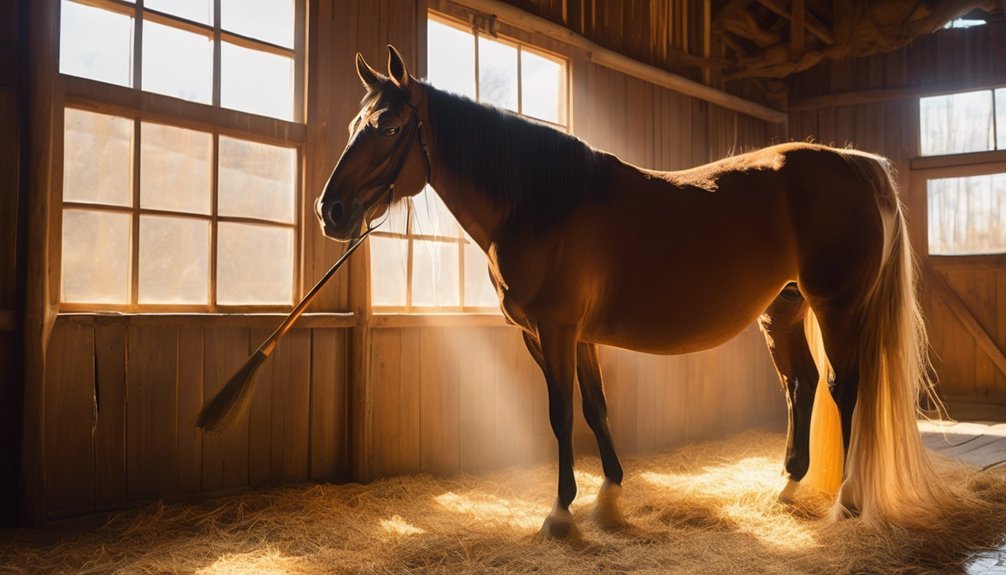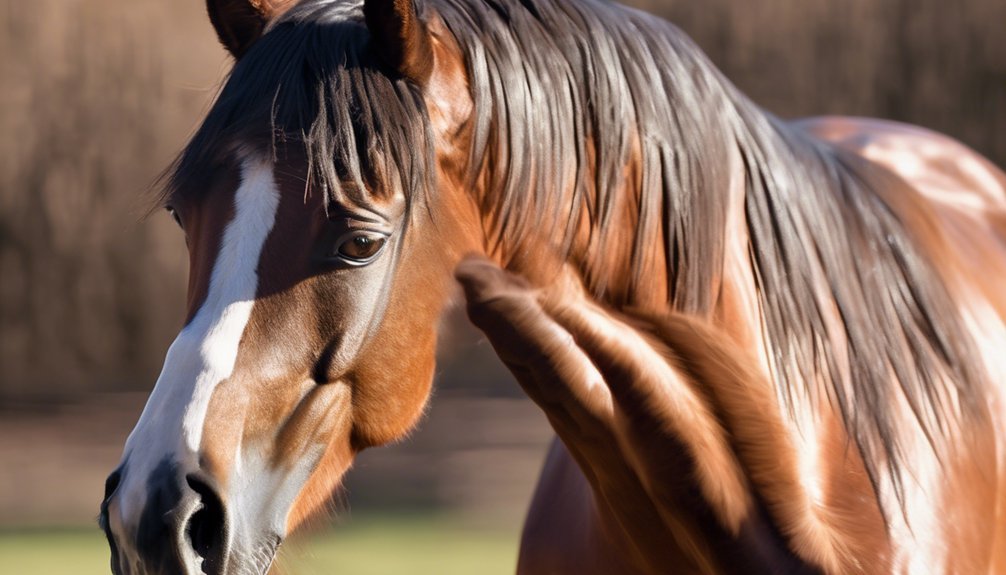
Did you know that a horse can lose up to 80% of its coat during shedding season? This process can be overwhelming if you're not prepared. To keep your horse looking its best, you'll need to adopt a consistent grooming routine and pay close attention to nutrition and skin health. Understanding what tools and techniques to use can make all the difference. Let's explore how you can effectively support your horse through this transition.
Key Takeaways
- Groom your horse three to four times a week to remove loose hair and promote skin health during shedding season.
- Use a curry comb to loosen dirt and hair, then follow with stiff and soft brushes for a thorough clean.
- Bathe your horse every two to four weeks with lukewarm water to help remove excess dirt and shedding hair.
- Ensure your horse's diet is rich in Omega-3 and Omega-6 fatty acids, vitamins, and minerals to support a healthy coat.
- Regularly check for skin irritations or parasites while grooming to maintain overall coat health and comfort.
Understanding the Shedding Process

As you prepare to care for your horse, understanding the shedding process is crucial, especially since it can significantly impact their coat's health and appearance.
The shedding cycle is a natural rhythm that varies with the seasons, often kicking into gear as daylight increases in spring. During this time, your horse will lose their winter coat, making way for a lighter, more breathable summer coat.
Pay attention to coat texture; a healthy coat should feel smooth and shiny, indicating proper nutrition and care. As hairs begin to fall out, you might notice some patches or unevenness.
Recognizing this process helps you support your horse's transition, ensuring they maintain a vibrant and healthy coat throughout the seasons.
Proper Grooming Techniques
Following the shedding process, proper grooming techniques become vital for maintaining your horse's coat health.
Regular grooming not only removes loose hair but also stimulates the skin, promoting a shiny, healthy coat. Aim for a grooming frequency of at least three to four times a week, adjusting based on your horse's needs.
Start with a curry comb to loosen dirt and hair, then follow up with a stiff brush to remove debris. Use a softer brush for sensitive areas, focusing on showing techniques that enhance the coat's natural shine.
Don't forget to check for skin irritations or parasites during each session. This intimate grooming ritual strengthens your bond with your horse while ensuring their coat remains in top condition.
Choosing the Right Tools

Selecting the right grooming tools is essential for maintaining your horse's coat health effectively. Start with grooming brushes; a good curry comb can help loosen dirt and hair, while softer body brushes remove dust and debris without irritating the skin.
Look for brushes with natural bristles to promote shine and health.
During shedding season, shedding tools become your best friends. A shedding blade or rubber curry can efficiently remove loose hair, making the process quicker and more enjoyable for both you and your horse.
Pay attention to your horse's preferences; some may love a particular tool while others may not. Investing in quality tools won't only ease grooming but also strengthen your bond, ensuring a happy and healthy coat for your beloved companion.
Bathing Your Horse During Shedding
Bathing your horse during shedding season can significantly enhance the grooming process and promote coat health. Aim to bathe your horse every two to four weeks, depending on their activity and how much dirt they've accumulated. Use lukewarm water to ensure comfort; extreme temperatures can stress your horse.
Before bathing, brush your horse to loosen dirt and shedding hair, making the bathing more effective. Use a gentle equine shampoo to avoid skin irritation, and rinse thoroughly to remove any residue.
While bathing, pay special attention to areas prone to dirt buildup, like the mane and tail. After the bath, dry your horse with a clean towel or allow them to air dry, stimulating blood flow and helping with shedding.
Nutrition for a Healthy Coat

To ensure your horse has a shiny, healthy coat, it's essential to focus on their nutrition, as what they eat directly impacts their skin and fur quality.
Start by providing a balanced diet rich in vitamins and minerals, particularly those that promote coat health. Omega-3 and Omega-6 fatty acids are crucial; they nourish the skin and enhance coat shine.
Consider adding vitamin supplements, such as biotin and vitamin E, to support healthy fur growth. Additionally, coat conditioners can play a vital role in maintaining that luster. Look for natural options that provide moisture and protection.
Regularly assess your horse's diet, and don't hesitate to consult with a veterinarian to tailor a nutrition plan that best supports their unique needs.
Maintaining Skin Health
While a shiny coat often steals the spotlight, maintaining your horse's skin health is just as crucial for their overall well-being. Start by ensuring proper skin hydration; you can do this by providing plenty of fresh water and considering supplements that promote moisture retention.
Regular grooming not only removes dirt and loose hair but also stimulates blood flow, which nourishes the skin.
Don't forget about sun protection, especially for horses with lighter coats. Applying a UV-blocking sunscreen or using protective sheets can help prevent sunburn and skin damage.
Regularly check your horse's skin for signs of irritation or infection, addressing any issues promptly. By prioritizing skin health, you'll support a vibrant coat and enhance your horse's comfort and happiness.
Creating a Comfortable Environment

A horse's environment plays a significant role in their overall comfort and coat health. Ensuring your horse feels secure is vital, especially during shedding season.
You'll want to maintain a stable temperature and prioritize ventilation importance in their living space.
- Keep the barn clean and dry.
- Use bedding that absorbs moisture effectively.
- Ensure adequate airflow to prevent respiratory issues.
- Provide shade in outdoor areas during hot days.
- Regularly check for drafts that could cause chills.
Regular Exercise and Its Benefits
Regular exercise not only keeps your horse physically fit but also plays a crucial role in maintaining a healthy coat. Engaging your horse in structured exercise routines helps stimulate blood circulation, which nourishes the skin and promotes a shiny, vibrant coat.
Regular workouts also aid in shedding the old hair, making room for new growth. You'll notice the physical benefits as your horse gains muscle tone and stamina, contributing to overall well-being.
Whether it's a brisk trail ride, lunging, or playful turnout in the pasture, consistency is key. Aim for a balanced regimen that includes cardiovascular and strength-building activities.
Monitoring for Skin Issues

To ensure your horse maintains a healthy coat, keeping a close eye on skin issues is essential. During shedding season, your horse's skin can become sensitive, leading to skin irritation or allergies. Regular monitoring can help you catch any problems early.
Here are some tips to keep in mind:
- Check for redness or swelling after grooming.
- Look for unusual bumps or lesions on the skin.
- Monitor for excessive scratching or biting at certain areas.
- Be aware of seasonal allergies that may affect your horse.
- Keep an eye on changes in coat texture or shine.
Frequently Asked Questions
How Often Should I Groom My Horse During Shedding Season?
You should groom your horse daily during shedding season. Use effective grooming techniques and shedding tools to remove loose hair and dirt. This not only keeps their coat healthy but strengthens your bond with them.
Can Stress Affect My Horse's Shedding?
Absolutely, stress factors can disrupt your horse's shedding cycles. If you're worried about stress affecting your horse, focus on creating a calm environment, as a relaxed horse tends to shed more naturally and evenly.
Are There Specific Supplements for Coat Health?
Yes, you can enhance your horse's coat health with specific supplements. Look for omega-3 fatty acids, biotin, and antioxidants that improve coat nutrition. These supplement types promote a shiny, healthy coat and support overall well-being.
What Signs Indicate My Horse Is Shedding Normally?
You'll notice your horse shedding normally by observing consistent shedding patterns and a healthy coat condition. Look for evenness in hair loss, no bald patches, and a coat that feels smooth and shiny.
Is It Normal for My Horse to Lose Weight During Shedding?
It's not uncommon for your horse to experience weight loss during shedding due to increased energy expenditure and stress. Monitor their diet and health closely, as other shedding causes may also contribute to unexpected weight changes.
Conclusion
By embracing regular grooming, prioritizing balanced nutrition, and creating a comfortable environment, you can ensure your horse's coat remains vibrant and healthy during shedding season. Stay vigilant for skin issues and adapt your care routine as needed. Remember, a well-groomed horse not only looks great but feels great too. Commit to these practices, cherish the bond with your horse, and enjoy the beauty of a shiny, thriving coat throughout the changing seasons.





